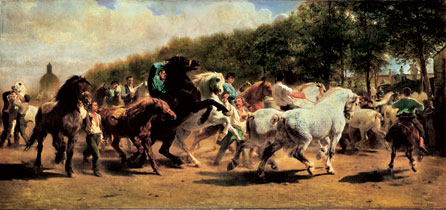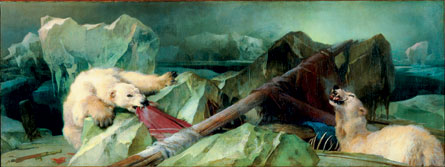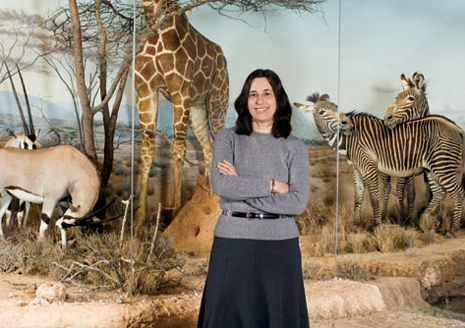Back
Fierce Friends:
Artists and Animals, 1750–1900
By Graham Shearing, Independent Art Critic
W.C.
Fields, when he was asked whether he liked children,
responded “I like children — fried.” So
what about animals? Variously served, they are indeed
delicious. But they are also dished up as “man’s
best friend.” Frequently, we find ourselves
pitted against them. And, just as often, we need
to save them.
What are we to make of this
complex paradox? At Carnegie Museum of Art, such paradoxes
become kaleidoscopic
in the exhibition Fierce Friends: Artists and Animals,
1750–1900, which looks at the animal world
and how mankind—and artists in particular—have
responded to it.
Surely, you might ask, isn’t this the territory of Carnegie
Museum of Natural History next door, where science trumps art
and a healthy rationalism keeps our more subjective intuitions
in check? It could have happened that way, but this exhibition
is the product of two art-historical minds: Louise Lippincott,
curator of fine arts at Carnegie Museum of Art, and Andreas
Blühm, former head of exhibitions and display at the Van
Gogh Museum in Amsterdam and current director of the Wallraf-Richartz
Museum in Cologne. Together they have stretched the ordinary
parameters of an art exhibition, pulling in both science and
moral philosophy. In fact, for the Pittsburgh showing of Fierce
Friends, which opens to members on March 25 and to the public
on March 26, Lippincott tapped the expertise—and the
collections— of her colleagues at Carnegie Museum of
Natural History to make the exhibition even more scientifically
significant.
Lippincott and Blühm joined forces once before
in the 2000-2001 exhibition, Light! The Industrial
Age, 1750–1900,
Art and Science, Technology and Society. Looking back on
that first
joint endeavor, Lippincott acknowledges, “Both the
concept and structure of Light! were quite radical, and Fierce
Friends works upon a similarly adventurous blueprint.”
In a
review of the Amsterdam showing of the exhibition in London’s
daily Telegraph,
distinguished art critic Richard Dorment recognized the
show’s
ambitious and innovative design. But it was his comments
about the show’s curators that made the biggest impact: “For
my money, they are the most interesting art historians
working anywhere in the world today.
Lippincott and
Blühm settled on the subject of animals
over conversations (and coffee and Dutch apple pie enjoyed
in museums and cafés throughout Amsterdam) shortly
after Light! Blühm recalls: “We had skirted
the subjects of 19th-century radicalism and industrialization,
and then
we fell upon animals and the fact that Darwin was arguably
a more lasting influence than Freud. We decided then to
see how the subject worked out.”
Lippincott adds, “We
were struck by the paradox that a show about animals is
really about people.”
Pests, Pets, Power, and Protein
The period covered by the exhibition, 1750 to 1900, is a loose
timeframe used by the curators to explore man’s relationship
with animals and how it changed as humankind’s knowledge
of the natural world expanded. Four key themes emerge: animals
as pests, animals as pets, animals as a source of power,
and animals as a source of food.
The first viewpoint considers
animals as pests: creepy crawlies, critters that bite,
destroy our material goods, and cause us
discomfort or unease. A flea, a wasp, a spider, a bat, a
weasel, and a snake all make an appearance here in paintings,
prints,
ceramics, and drawings by artists both world-famous and little
known (you won’t see this happening in many art museums;
this selection is completely unpretentious).
By contrast,
the works that consider animals as pets evoke all our softer
sentiments. This brings out the artists in
force, particularly the French, who are well known for
exploring and
testing our emotions with their works.
Eighteenth-century
Europeans cast their pets in the characters of their owners,
be they high or low. Jean-Baptiste Oudry’s
(1686-1755) portrait of a female hound suckling her puppies
proclaims the moral virtues of the good mother. And a
weeping girl politely laments the death of her pet in a work
by
Jean-Baptiste Greuze (1725-1805). In the context of the period,
this painting
unleashes a host of classical references and moral warnings.
While pests and pets are still with us today, we realize
by studying the art of the past that we are losing familiarity
with powerful animals. Until the mid- to late 19th
century, animals were the critical source of power in the world,
carrying soldiers into the field of battle, working
the
fields, and
providing transport. In 1750, it was all horses and
oxen. By
1900, it was increasingly horsepower.
Rosa Bonheur’s
The Horse Fair (1855), is a reduced version of a 16-foot
painting shown in the Paris Salon of 1853. It
still conveys the majesty and power of the Percheron,
the great French draft horse, but it is on the verge
of becoming an elegy
for a way of life, at least in the Western world. The
buildings in the background are the modern, urban Paris;
the steam engine
has long been invented, and the horse is gradually
losing its place in the public thoroughfare.

Then,
of course, there is the animal as a food source. Today, while
we still know that to enjoy a nice steak
or a haunch
of venison an animal must die, we are largely spared
any direct sense of it. We might eat differently
if every neighborhood
still featured a slaughterhouse. But animals remain,
for most
people, an essential source of food, which is the
fourth category devised by Lippincott and Blühm to denote
aspects of our perception of animals in daily life.
Paintings of dead game often graced the dining room walls
or entry halls of 18th-century homes. Oudry’s
A Hare and a Leg of Lamb (1742) exemplifies luxury
and the good life to visitors who might be expected
to salivate in
its uncannily real presence. At the same dinner
party, an earthenware head of a boar might grace
the table as a tureen; and diners
might eat off plates decorated with animals, birds,
or fish made from fine porcelain.
Discovery Breeds
Understanding
By 1750, the world was almost completely discovered
and crudely mapped. But much of the animal world
remained a closed book,
only occasionally yielding up its hidden secrets.
And they were true treasures, things of wonderment
to be
viewed
in amazement before being rationally comprehended.
For the artist, the task of representing such exotic animals
was seldom easy. Often the corpse was the
only model, sometimes
the tanned pelt, a skeleton, or a skinned bundle
of feathers. (Even van Gogh kept by him the stuffed
skin
of a kingfisher.)
Reconstruction was tentative and often amateurish.
Handling the pages of an album of etchings of a leopard by
the master printmaker Paulus Potter,
Lippincott
points out
that we can detect, despite the imaginary landscape
surrounding the beast, that the animal was likely
caged and probably
malnourished or sick and disabled by its unnatural
environment. As a complement
to this portion of the exhibition, Lippincott
will include a small but immensely valuable survey of
taxidermy, partly
drawn from the reserves of Carnegie Museum of
Natural History next door.
As knowledge of the natural world
began to deluge the 18th century, suddenly scientists had
to deal with
it, turning
the new material into taxonomic systems, sifting
and constantly rearranging things as new discoveries
were
made. Artists
had
to keep up, balancing the instinct to beautify
and decorate in the search for a collected
realism.
Consider the Giraffe painted by an unknown
Frenchman around 1785. The specimen was not
alive; only
the skin was available
for study. Then compare it to the portrait
painted less than 50 years later by the Swiss
Jacques-Laurent
Agasse
(1767-1827)
of a live giraffe that was presented to King
George IV (see cover). The animal looks right,
even if
it is being
fed milk
from a bowl like a domestic cat, indifferent
to the tempting leaves on the trees above.
The Comte de Buffon’s comprehensively illustrated Natural
History, 1749-1788, is one of many encyclopedic
works that might have been found in any educated man’s
library at the time. And as science spilled out into the general
culture,
porcelain plates and other objects derived
from work by Buffon and his contemporaries began to fill the
home. Several stunning
examples of these household items from the
Museum of Art’s Decorative Arts Department will be included
in the exhibition to provide a parallel to
Buffon’s flat,
illustrated pages.
A Date with Darwin
By the 19th century, the amount of scientific material that
had been collected and catalogued enabled bolder speculation.
Enough bones, feathers, and other structures came together
to tell new stories through comparative anatomy. The study
of both living animals and those long extinct offered a prospect
of theories that questioned older beliefs. After 1859, the
year of the publication of Charles Darwin’s The
Origin of Species, the primacy of man, created (in an instant) by
God, was no longer so firmly asserted. And artists, whose
minds often are more intuitive than rational, became profound
commentators on the subject.

Sir Edwin Landseer’s Man
Proposes, God Disposes (1863–64),
created during the first wave (there have been many) of the
Darwinian furor, neatly projects an artistic question mark
into the painting. Two polar bears sift the remains—a
rib cage and wreckage—of an ill-advised Arctic expedition.
In this painting, clearly the fittest survive; but what does
the carefully chosen title of the work import, if not a grim
irony?
In essence, the exhibition traces the evolution of
animals as creatures to be owned, used, and eaten by mankind
to the
uncomfortable truth that humans are properly ranked as
animals themselves, however special. Time and other circumstances
have changed our attitudes toward our Fierce Friends; we
have grown
closer to them, yet at the same time we find ourselves
further
distanced from them. Much of this change has been little
noticed by the average man, and Lippincott and Blühm
draw attention to our ignorance.
Back | Top

PHOTO: TOM ALTANY
|
CLOSE-UP
Louise Lippincott, Curator of Fine Arts
by Kimberly Tarquinio
Recently lauded by British
art critic Richard Dorment as one of the most interesting
art historians working in the world today, Louise
Lippincott joined Carnegie Museum of Art as curator
of fine arts in 1990. While simultaneously working
on several other key projects, Lippincott spent
the last three years working long-distance with
Andreas Blühm, former head of exhibitions
and display at the Van Gogh Museum in Amsterdam
and current director of the Wallraf-Richartz Museum
in Cologne, to organize the exhibition Fierce
Friends: Artists and Animals, 1750–1900. It was the
second successful collaboration for the two curators;
they organized Light! The Industrial Age, 1750–1900,
in 2001.
Lippincott and Blühm
were introduced by a mutual friend and colleague
from Philadelphia,
and they connected instantly over a shared interest
in art and science in the late 18th and 19th
centuries. When asked how they were able to assemble
two wide-ranging,
critically acclaimed exhibitions over such a
short timeframe—and from opposite sides of
the Atlantic—Lippincott replies, “E-mail.
Without it, these projects would have taken a
lot longer and cost a whole lot more. Being able
to
talk online and share files instantly really
simplified the whole collaborative process.”
Without
communication issues to contend with, Lippincott
says the hardest thing about organizing
the two
exhibitions was arranging important loans from
other museums. Fortunately, both times, Lippincott
was able to borrow a wealth of artifacts and
specimens from Carnegie Museum of Natural History
next door
that complemented the works of art she and
Blühm
had chosen. “My colleagues at the Museum
of Natural History have been incredibly helpful
and generous,” she says. “Their
collections were instrumental in both Light! and Fierce Friends.”
Though Lippincott
and Blühm share a passion
for the time period covered by Fierce Friends,
Lippincott says they approached the subject
of animals differently. “My grandfather
had a farm; I love to ride horses; and I’ve
always had pets. Being so familiar with animals,
I often
found myself selecting artwork based on the
animals depicted. Andreas isn’t as fond
of animals as I am, so he selected pieces based
on the work
itself or the artist. It had never occurred
to me to extend my fondness for animals to
my work,
but once the two came together, my personal
background proved to be quite useful.”
By
all accounts, Lippincott and Blühm make
a great curatorial team. Both of their exhibitions
have been well received by audiences, scholars,
and critics alike. “Our projects have
been immensely rewarding,” she says. “I’ve
started to see some of our ideas pop up in
other places and it’s very gratifying.
It would be nice if we started a trend.”
Is
a third collaboration in the works? Lippincott
replies, quickly: “I never say never.
My guess is we’ll probably work together
again, but I can’t think about that right
now. I have a show to put on here in Pittsburgh
first.”
|
|
Back | Top
|